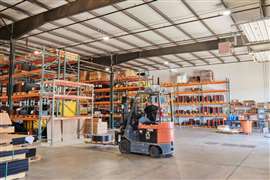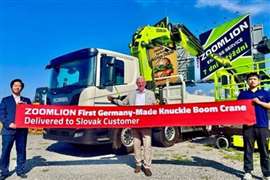Gantry founder
01 May 2008
“I grew up in the contracting business,” says Gary Lorenz. “My father was a house mover and in the excavator business and in the local trucking business in Clear Lake, Iowa. I've always liked equipment and machinery.”
After leaving college in 1961, having previously served three years in the Marine Corps, Lorenz joined the sales and marketing team at Link–Belt Speeder in Cedar Rapids, Iowa and went on to spend the first 17 years of his career in the crane business. After Link–Belt he joined Sargent Engineering in Fort Dodge, Iowa, then P&H and then Grove. This was the early days of the development of the hydraulic crane industry and Lorenz learned a lot, being on the marketing side of new product development.
In 1978 he left crane manufacturing to become president of Daniel Hamm Heavy Rigging & Transport Company in St Louis, Missouri. The move was to prove significant, for not only did it spark an entrepreneurial spirit in Lorenz but it also introduced him to the opportunity that was to make his name.
Daniel Hamm put into service the world's first telescopic hydraulic gantry. It was built by Ed Engler of Modern Hydraulics. Engler had previously worked for Belding Engineering Company, the earliest pioneer of hydraulic lifting gantries and a part owner of Modern Hydraulics. “Ed Engler was closing his rigging business in Chicago and had an auction to sell his gantry. Daniel Hamm bought it,” explains Lorenz. Th is first two–legged telescopic gantry was “a home made type of thing that used dump truck cylinders,” Lorenz recalls. But it worked fine. The gantry telescoped from 8 to 24 feet high and had a capacity of 75 tons per leg. Lorenz, who had added a gasoline–fueled power pack, saw new possibilities.
In 1980 he set up Linden Lorenz Rigging Company in Davenport, Iowa, in partnership with Bill Linden.
“There were a few companies building homemade gantries, primarily single–stage hydraulic cylinders, that were very long and difficult to move around and set up,” he says, but no one was producing them on a commercial basis. The crane manufacturers weren't interested, he says, because the market was not big enough for them. As well as Linden Lorenz Rigging, Gary Lorenz also teamed up with Ed Engler, who he had first met at that auction, and Roger Johnston, an engineer with whom Lorenz had worked at Sargent and P&H. Together they established Riggers Manufacturing Company to build two–legged telescopic hydraulic gantries for Linden Lorenz and other rigging companies. “I laid the concept down, Roger Johnston did the drawings and the engineering and Ed Engler built them and taught people how to use them,” Lorenz says. “My part of Riggers Manufacturing was to contact all the rigging companies, talk to them and sell to them.”
Different ideas
In 1983 a difference of opinion saw Lorenz quit Riggers and set up 4–Point Lift Systems in competition, based in Davenport. “It was a little difficult,” he admits. “Ed Engler and I had different ideas. Ed wanted to keep building the same machines, and bigger. I wanted to be more modular and have four legs instead of two.”
It was a bad year for the construction equipment industry, 1983, and Linden Lorenz's order book was heavily based on moving machinery for John Deere and Caterpillar plants. “We had to decide whether to start going further a field and bidding all over the country,” he says. Instead the doors were closed in early 1984 and Lorenz focused his energies on manufacturing gantries. Lift Systems relocated to a larger facility in Moline, Illinois where it remains today.
In the same year, Roger Johnston also split from Engler. He started producing hydraulic gantries at his J&R Engineering business, which he had started in 1978 as an engineering consultancy. The three musketeers were now all competitors.
Over the next 20 years these three companies, between them, put telescopic hydraulic gantries into just about every rigging company in the country, opening up new opportunities for moving heavy and difficult loads. “I don't know if there's a rigger out there that doesn't have at least one set of telescopic gantries and many of them have several sets.” Lorenz says.
For 4–Point Lift Systems, as for the others, growth was steady. “There were never any extremely large years. All of the machines that have been built are, to the best of my knowledge, still out there.” This has proved to be part of the shortcoming of the business model. It was a niche market that was eventually satisfied. 4–Point Lift Systems expanded its product line to ofer different kinds of rigging equipment, such as the Mobilift and the Twinlift, mobile rigs that are kind of a cross between an industrial lift truck and a telescopic hydraulic gantry system.
Activity range
Lorenz's involvement in the hydraulic gantry business went beyond manufacturing. He was involved in numerous related enterprises along the way. After closing the doors of Linden Lorenz in early 1984, he set up Heavy Lift & Engineering in Davenport with former employee Mike Osborne as manager and co–owner. “When I got out of rigging to build gantries, he wanted to stay in rigging.” Th ere was Lift Systems Canada in Woodstock, Ontario that got round the swingeing tarifis by importing major components from Moline and building gantries locally. There was Lift Equipment in Cleveland with Earl Swann; and Mega Lift in Montreal, Canada. Lorenz was also a partner in Rigging Gear Sales, established by Bruce and Bonnie Forster.
There was no grand plan to help develop his own customer base, Lorenz says. In each case there was simply someone he knew with whom an opportunity arose. It was the culmination of many years of building contacts and friendships in the crane and rigging business.
“It is really all based on people. If I came across someone with the right drive and they wanted to do something and I was able to help, then we could do something,” he says. “It was a case of if you know the people and can help, that was part of it, but all of them were using Lift Systems [gantries] in some way.
In each case, Lorenz's partners bought him out after a period of time. His role was always to help get things started, it seems.
In 2001 Lorenz handed over day to day management of Lift Systems to his daughter Lisa Janis, who was appointed president. A year later Lift Systems, in partnership with Rigging Gear Sales, acquired Riggers Manufacturing–the company Lorenz had helped found back in 1980. Ed Engler had retired a few years previously and sold out to Dave Pokraka.
In March this year Lorenz turned 70 and he and his family took the decision that it was time to sell up. (See Specialist consortium acquires August, page 7.) “It was time. At my end you can see the end, I guess,” he says. By July a deal was concluded, selling the business to a consortium made up of Bruce and Bonnie Forster, along with Ron Hall of Mid–Atlantic Lift Systems (distributor of Virginia and North Carolina) and Glenn Blair, Lift System's long–serving CPA (certified public accountant).
Relationships
Much of Lorenz's career success has been based on relationships, and many of these have been forged over the years through his long and deep association with the Specialized Carriers & Rigging Association. He attended his first meetings when at Link–Belt in the 1960s and it was the knowledge gained and the relationships made and cemented here that enabled him to and a customer base for his telescopic hydraulic gantries.
“The SC&RA is a meeting place for people with ideas so that everyone can share experiences and work together to develop the industry. The SC&RA has done an extremely good job at that, and even in this age of consolidation, with companies taking over companies, they are actually growing their membership.” Th at is testament to the value that members get out of it, he says.
It was the SC&RA that gave Lorenz the three proudest achievements of his career. The first was Linden Lorenz's victory on the Rigging Job of the Year competition in 1981. “It was only our second year,” he recalls. The job was building a press in a John Deere factory in Davenport. “We had to devise a way to get the crown on top when there was hardly any headroom as it was close to the trusses overhead.” He remembers vividly the ‘wheelbarrow handles’ type configuration that was rigged up, with the hydraulic gantry pushing up from beneath.
In 1999 came an SC&RA lifetime achievement award for his contribution to the industry.
In 2001, after a rule change that made it possible, he became the first Allied Member to become president. “It was a great honor for me,” he says.
He is not the only member of the family to have been deeply involved with the organization. Daughter Lisa has served on numerous committees and chaired some of them, while his wife Mary Ellen has been a pillar of the Ladies’ Group for 25 years or more. Among other things, she has been instrumental in the major fundraising initiatives of the SC&RA Foundation.
Asked what pearls of wisdom, gained from his years of experience, he would pass on to the next generation, he replies: “It always pays to do the right thing, whoever you are dealing with. It may be expensive to begin with but it always pays for itself in the long run.”
Take warranties, for example, he suggests. “If it turns out that something is not made properly, it doesn't matter how old it is, you have to put it right.”
Looking to the future, he predicts lifting gantries becoming more high–tech. Level indicators have been around for 15 years or so, but height indicators, load indicators and even travel indicators are becoming more prevalent to help ensure gantry legs stay square and level. The use of load pins in cylinders can guarantee safety, he says “We are moving in that direction now. We are getting to the position where people realize that it is worth buying into these devices because of the safety and productivity they give you.”
This has not always been the case. Lift Systems has ofered a computer–controlled unified lift device that guarantees all legs stay at level height, but few customers have been prepared to pay the $40,000 to $50,000 extra cost. “Lift Systems is now working on something that will do the same thing for considerably less cost,” he reveals.
He worries, though, that in these days of globalization the smaller rigging companies will and it harder to compete. When a major industrial concern relocates its production to China, for example, only the biggest rigging companies can follow it there to install the machinery.
Overall, however, he expresses great confidence in today's generations of riggers, who now take for granted the product Lorenz helped to pioneer. He is not one of those 70–year–olds who thinks everything was better in the old days.
“I think a lot of the things that people in this industry are doing are just amazing–the methods and the type of work they are doing. Machines are getting bigger, lifts are getting higher and the industry is coping with it very well.
STAY CONNECTED


Receive the information you need when you need it through our world-leading magazines, newsletters and daily briefings.
CONNECT WITH THE TEAM











